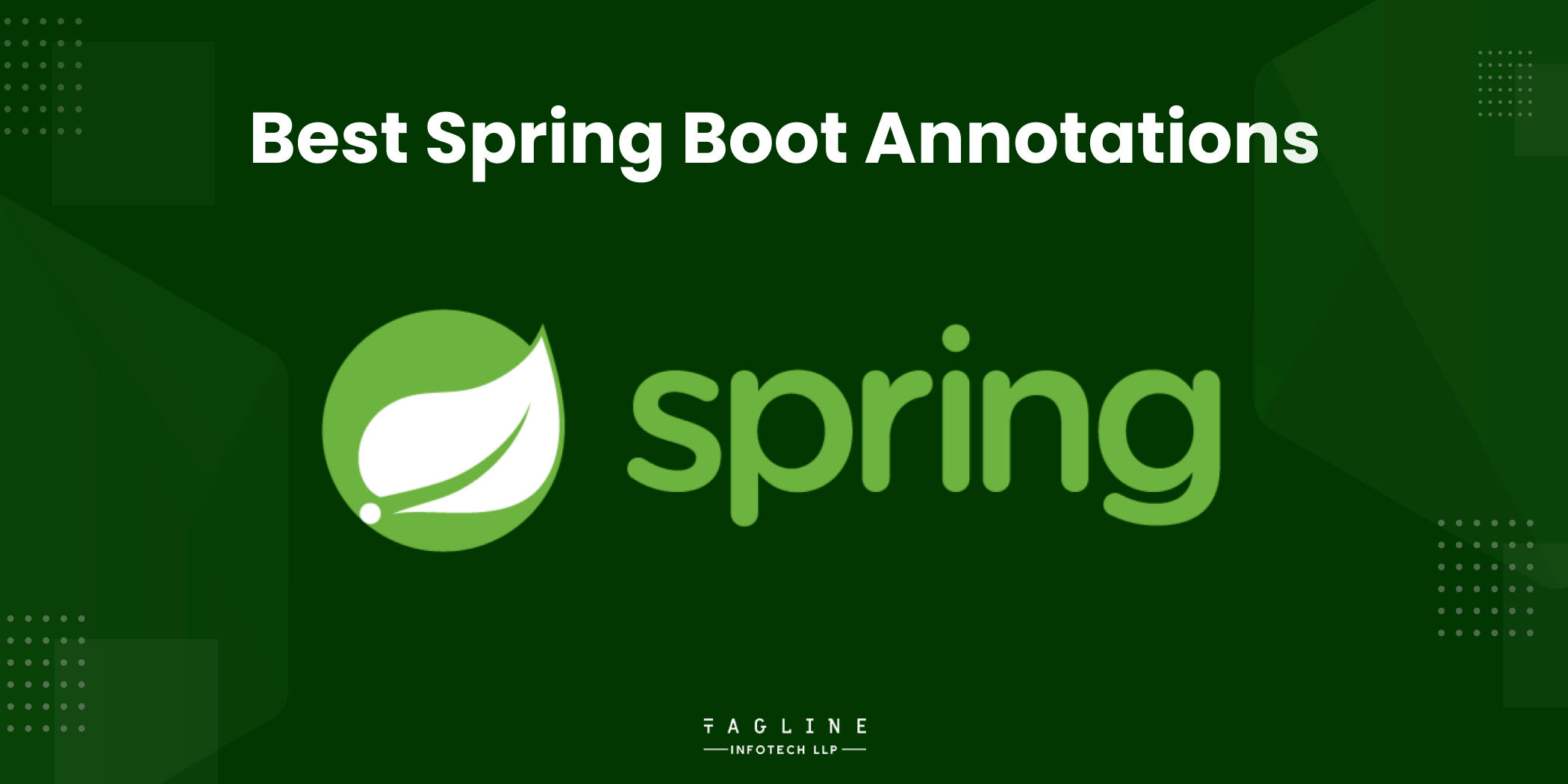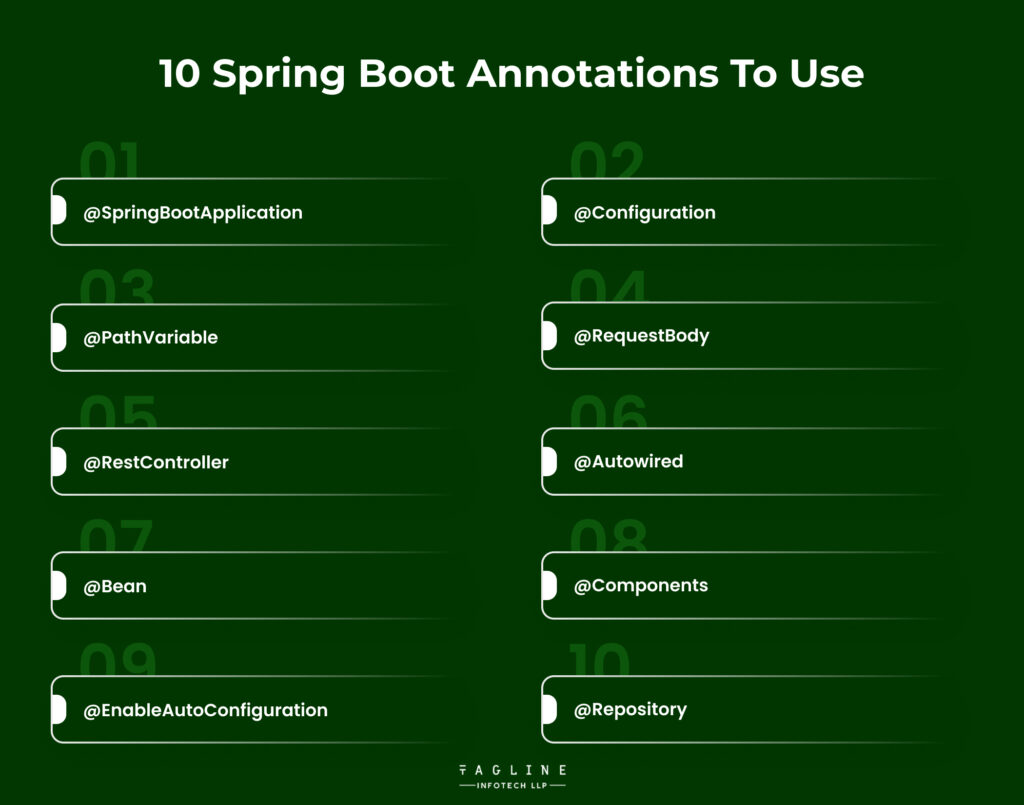React Native Vs. Native: Which Is Best For...
April 29, 2024
Home >> Java >> Best Spring Boot Annotations

Quick Summary
Spring Boot annotations are like specialized tools in a toolbox that help you build efficient and productive apps. Each annotation focuses on solving specific issues and configuring your application. By using these annotations, you can optimize performance, stay competitive, and speed up development in Spring Boot.
Spring is often used to create scalable applications. The Spring MVC module is one of the most often used parts of the Spring framework for building scalable web applications. Web applications can be used with Spring MVC.
Even with this, the most significant disadvantage of spring projects is that setting everything up takes a lot of effort and might be difficult for novice developers. If you are still familiar with the application procedure, it will take some time to prepare the production application.
Spring Boot provides the solution to this issue. All of the qualities connected with SpringSpring are incorporated into the construction of Spring Boot, which is built on top of the SpringSpring. Furthermore, because it offers a production-ready environment quickly, it has recently grown in popularity among developers. This makes it easier for developers to focus solely on the logic rather than fumbling with setup and configuration.
With the help of the microservices-based Spring Boot framework, it is possible to create an application that is prepared for production quickly.

Three Spring Boot annotations—@ComponentScan, @Configuration, and @EnableAutoConfiguration—are incorporated into the @SpringBootApplication annotation, an important class of annotations. This annotation belongs to the Spring Boot annotation family and is located in the root package. It is also a meta-annotation of the application.
By using the @SpringBootApplication annotation, developers can alter the application and take advantage of the Spring Boot framework’s numerous features. Furthermore, the integration of the functionality of many annotations reduces the quantity of boilerplate code required to configure programs.
The @SpringBootApplication plugin lets you configure the Spring application more efficiently. This annotation allows programs’ attributes to be customized and changed. Because of this, developers can tailor web apps to match the project’s needs.
The class-based @Configuration annotation can be used to declare one or more bean methods inside the class. A configuration class’s duty is to provide information about the application context, which consists of the service and other application components.
This enables developers to create highly efficient and adaptable apps that can quickly adjust to requirements changes. Thanks to the @Configuration annotation, more classes can be imported. Configuration classes can be categorized by domain or functionality using the custom annotation provided by Spring Boot.
Furthermore, depending on the state of the environment, a configuration class can activate or deactivate particular components. Hire Java developers can write code by substituting large XML configuration files with the @Configuration, which allows for more flexibility.
The @PathVariable annotation monitors dynamic parameters from the request URI and translates them to method parameters in a controller. It helps construct RESTful web services by allowing you to manipulate variable parameters.
Furthermore, it allows developers to handle incoming requests and dynamic parameters without writing excessively complex code. Given this, you can use @PathVariable to create a more accurate mapping for URI requests and controller function requests.
You may easily tweak it and connect it with other Spring Boot annotations, such as @RequestMapping and @GetMapping, using the SpringBoot annotation. Programs are ensured to keep their security due to the robust annotation.
In web applications, the method parameter @RequestBody is responsible for binding the HTTP request body to the controller method. Users’ requests to the server are converted into a map.
The request helps resolve the procedure by including information from the sought body. Conversely, deserialization depends on the kind of content, even if it is an automatic operation. The data can be in numerous formats, including JSON, XML, and plain text.
The application uses the @Requestbody annotation to convert the Java object the controller returns into the resource representation RESTful requested. For instance, if the user submits a request body including details about the new users, the annotations will link the application programming interface (API) to the user object.
The @Controller and @Respondbody annotations’ functionalities are combined in the @RestController annotation. The annotation makes creating RESTful endpoints that provide XML, JSON, and other types of responses easier.
RestController annotations generated with Spring Boot can also react to images, plain text, and PDF documents. As an extra feature, Spring Boot sets up the HTTP response automatically. Nevertheless, you can customize the method by using the Rest Controller annotation.
Furthermore, you won’t need to include the @Respondbody annotation for the request mapping methods if you annotate the controller class with the Rest Controller annotation.
In SpringBoot, the @Autowired annotation is used to inject the dependency of one bean into another bean. A class needs another individual object to incorporate a spring-managed object into it for it to perform its functions.
As a result, Spring Boot will automatically inject the dependency and find the bean that corresponds to the field or parameter that you have not provided when you annotate a field or a method with the @Autowired annotation. With the @Autowired, injection may be done in three different ways: constructor injection, setter injection, and field injection. Stated differently, the object’s entire life cycle is managed by the Autowired annotation feature of Spring Boot.
An annotation at the method level called @Bean is commonly used in Spring Boot applications. The bean annotation is a direct equivalent of the XML element in the same way that it indicates to the Spring container that a method must be registered.
Spring bean annotations are the objects that allow annotations to be injected into other components or other beans. Additionally, it can be used in place of the XML tag. Creating or sharing @Bean annotations with the entire application environment is feasible because they are singletons.
In conclusion, @Bean annotations are a helpful tool for creating and managing beans in Spring Boot applications.
The @Component annotation signifies the Java class within Spring applications, a key feature of Java Frameworks for Web Development. The Spring IoC container handles these component annotations and supervises the component lifecycle, encompassing initializing, creating, and destroying the components.
This means that any item in the application, including controllers and services, can be represented by a component. When the Java class indicated the @Component annotation, Spring Boot recognized the components with the help of the classpath.
Additionally, components inject the part dependencies in conjunction with @Autowired and @Qualifier.
You can program your Spring Boot applications to set them up using annotation automatically. You must activate Auto Configuration annotations to specify and configure the Spring components automatically.
Developer work is streamlined because the autoconfigured beans are already in the classpath. This is achieved by setting it up to run the apps and giving the required beans from the classpath. The @EnableAutoConfiguration annotation uses Spring Boot to consider the class’s default package.
Additionally, you can manually exclude specific classes from auto-configurations with the Spring framework boot. This functionality is handy when avoiding attaching particular courses to the auto-configuration feature.
The @Repository annotation allows you to work with several relational and NoSQL databases. In addition, Spring Boot will automatically construct and supply the required context to a Java class that has the @Repository annotation added.
Classified as a Repository in the annotation, it belongs to the data access layer and provides an application programming interface (API) for interaction. As a result, the developer can write less code. The class responsible for assuming the role of a data access object is designated by the annotation @Repository.
The Spring Data framework easily handles repositories, and flexible, reusable, and modular can be created using @Repository.
Despite the abundance of annotations, utilizing the necessary and valuable SpringBoot annotations is imperative. Mainly because too many annotations will make your code harder to read and more challenging to maintain.
For Spring applications, using the @ConditionalOnProperty will turn customizations on or off based on the property’s value. This will allow the creation of applications more effectively. Your apps will be customized based on outside circumstances because your work is more manageable.
Using @ComponentScan for integration testing makes it possible to use robust annotations. It also reflects any potential issues that might come up during the test’s execution and ensures that your test is being run correctly based on the behaviour of your application.
You can set global expectation handles that will be applied to all controllers in the Spring applications by using the @ControllerAdvice. It helps to resolve this issue by providing correct and consistent messages with the Spring Boot applications.
Enhancing your web applications’ performance, maintainability, and scalability can be achieved by integrating the robust annotations that Spring Boot offers into your development process. Using a range of components also simplifies and strengthens the development process.
This blog post highlights the top 10 Spring Boot annotations that will help you work more efficiently and finish your project more quickly. By leveraging every annotation’s benefits and features, your apps can be elevated to new heights.
Therefore, now is a great time to start using annotations for Spring Boot projects if you haven’t already. If you integrate them into your development flow, you will sustain a competitive advantage in 2024 and beyond.
With the open-source Java framework Spring Boot, microservices can be developed. On the other hand, configuration management and centralization are achieved using Spring Cloud, a configuration server technology. Configuration management is its primary function. Applications running on Spring Boot are guaranteed safe in several scenarios where Spring Cloud is deployed. Under its default configuration, Spring Boot can execute standalone web applications built on SpringSpring and implement Spring capabilities. The Spring Cloud platform, which offers a way to construct cloud services, is designed on top of the Spring Boot paradigm. It is decided to use Spring Boot for unit testing to reduce the time needed for integration testing.

Digital Valley, 423, Apple Square, beside Lajamni Chowk, Mota Varachha, Surat, Gujarat 394101
+91 9913 808 2851133 Sampley Ln Leander, Texas, 78641
52 Godalming Avenue, wallington, London - SM6 8NW